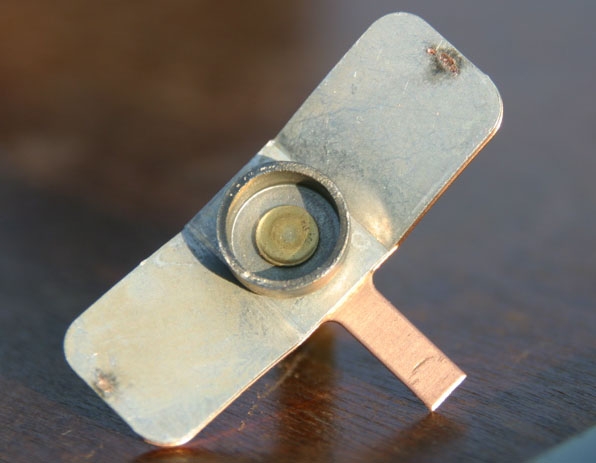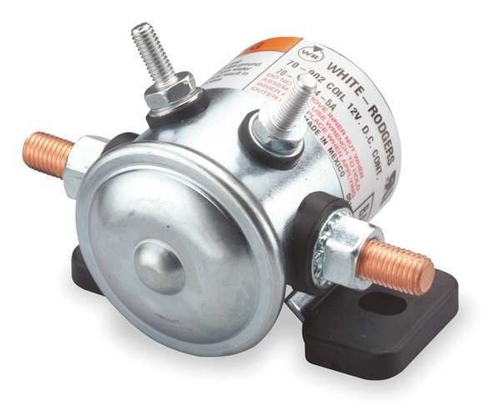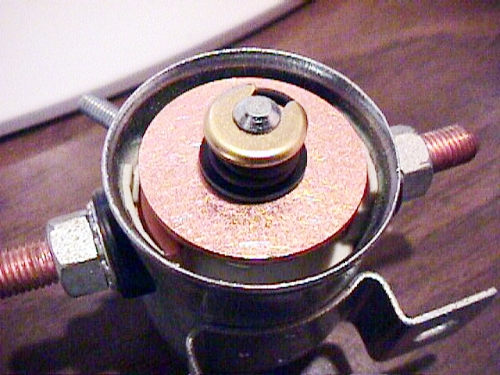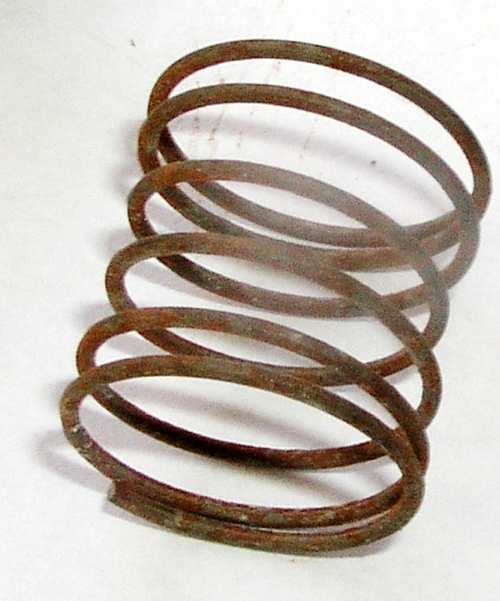 |
Matronics Email Lists
Web Forum Interface to the Matronics Email Lists
|
| View previous topic :: View next topic |
| Author |
Message |
nuckolls.bob(at)aeroelect
Guest
|
 Posted: Tue Apr 28, 2015 10:37 am Post subject: Starter Solenoid behavior with low Battery Posted: Tue Apr 28, 2015 10:37 am Post subject: Starter Solenoid behavior with low Battery |
 |
|
At 19:26 2015-04-27, you wrote:
--> AeroElectric-List message posted by: "Radioflyer" <skyeyecorp(at)airpost.net>
Recently my battery fell below 11 volts and so it could not provide enough power to completely turn over my engine. What surprised me more than the low battery was that after switching off my master and then switching it back on again, the starter attempted to turn the engine. Wow, the master isn't supposed to control the starter solenoid!
After charging the battery, the master and starter switches returned to normal operation and the engine started perfectly many times. All was good and I eventually figured out why my battery discharged. However, that still left me wondering how the master switch could possibly activate the starter solenoid without my pushing the start switch. My theory is that the low voltage only partially (weekly) engaged the starter solenoid spring and therefore the spring didn't exert full force to open the solenoid after it was de-energized. I'm not yet ready to conclude that the starter solenoid is actually defective. Anybody also experienced this?
Millions of times over the history of vehicular DC
power systems not the least of which are airplanes.
Contactors will perform as advertised
only if coil currents are maintained at or above
minimums required for that performance.
With a depleted battery, the voltage is low to
begin with . . . the internal resistance is also
high . . . meaning that the voltage drops still
lower when even moderately loaded.
This condition increases the probability of
starter contactor STICKING by several orders
of magnitude.
Contactos all have one characteristic in common,
they BOUNCE. Some worse than others but none are
zero. The designs that come very close to zero
are those specifically designed for starter control
service. Very light moving contacts. Lots of closure
pressure. Small contact area.
[img]cid:.0[/img]
These contacts have hundreds of start cycles on them with
what was probably a healthy battery. Drop the battery
to 10% capacity . . . the contactor will close but it's
going to burn on each bounce and perhaps stick.
If battery voltage is not 12.5 volts or more with
the master switch just closed, be cognizant of the
risk for contactor sticking that goes up exponentially
as battery condition goes lower.
Your starter contactor is probably fine but suffered
an unrealistic expectations event.
Bob . . .
| | - The Matronics AeroElectric-List Email Forum - | | | Use the List Feature Navigator to browse the many List utilities available such as the Email Subscriptions page, Archive Search & Download, 7-Day Browse, Chat, FAQ, Photoshare, and much more:
http://www.matronics.com/Navigator?AeroElectric-List |
|
| Description: |
|
| Filesize: |
110.71 KB |
| Viewed: |
4917 Time(s) |

|
|
|
| Back to top |
|
 |
nuckolls.bob(at)aeroelect
Guest
|
 Posted: Tue Apr 28, 2015 11:14 am Post subject: Starter Solenoid behavior with low Battery Posted: Tue Apr 28, 2015 11:14 am Post subject: Starter Solenoid behavior with low Battery |
 |
|
At 11:11 2015-04-28, you wrote:
--> AeroElectric-List message posted by: "racerjerry" <gki(at)suffolk.lib.ny.us>
Cessna Pilots Association (CPA) has recently uncovered a common error where starter contactors are sometimes installed upside down and where the weight of the plunger is working against plunger return spring. Contactors should always be installed with the case swaged lip facing DOWN. Terminal Studs should be nearer the bottom of the contactor, rather than the top. Unfortunately, some new contactors are appearing with labels inverted, which adds to the problem.
Even with the case lip facing down, CPA suggests adding sealant around the case perimeter at the lip to keep moisture out.
Ref: CPA Magazine, April 2015, p.47
Good grief . . . is that canard still circulating?
That was investigated several times at Cessna by
teams that never seemed to know what the other
teams had discovered . . . with no foundation
whatsoever laid for the assertions in the CPA
article.
First, GRAVITY has nothing to do with the
performance of ANY relay or contactor I've ever
encountered with ONE exception. Back in my
railroading days, a signals guy I met showed
me some antique signal relays he had collected
over the years. Railroad signal equipment remote
from AC mains was battery powered. Battery capacity
was sufficient for months of operation between
charges . . . but signal crews would change out
or recharge batteries at conservative intervals.
Even so, railroad signals designers had the
art of FMEA down decades before anybody bolted
a battery to an airplane. Did you know that crossing
gates are HELD UP with power? Not much . . . but
they're carefully overbalanced such that loss of
power drops the gate. Some relays were built without
springs and depended on gravity for motion in the
de-energized state. This simplified design by eliminating
springs.
The so called intermittent duty, whisky barrel
contactors . . .
[img]cid:.0[/img]
were never designed for starter motor service. Power
winch, hydraulic lift gates, etc, yes. But starter
motors . . . not so much. The problem got worse when
the TC guys starting bolding PM motor starters to
their products. Starter inrush currents went up
and the massive, copper ring that served as movable
contact
[img]cid:.1[/img]
is bouncy to the extreme.
There WERE some orientation issues with these contactors
but it had nothing to do with gravity.
When Cessna went to the floating cowl way back when, rain
running down the firewall of a sun-soaked airplane sometimes
splashed a contactor body which cooled and sucked in moisture
under the crimped-but-not-sealed closure cap. Moisture
sucked in as liquid had to escape as a gas during atmospheric
variations in pressure. Needless to say, the humidity inside
the contactor was 100% and guess what?
[img]cid:.2[/img]
Things got kind of cruddy inside . . .
[img]cid:.3[/img]
There was a ABORTIVE fix tried wherein all contactors
were 'sealed' around the terminals and the crimped
cap. The results were predictable. Failure rates went
down slightly but since the sealing was not hermetic,
liquid was still sucked in and vapor exchange went
down further.
The most effective FIX was to mount the contactor cap-down
and drill a tiny 'drain hole' in the center of the
cap. Actually, the hole served both as a vent to
reduce that sucking tendencies as well as
a more reliable exit strategy for any liquid
that would pool there.
Bottom line is that the whisky barrel contactor
has always been a poor performer as a starter
contactor 'Better gravity' won't help and
uckum-yucky over the openings is useless.
The car companies figured that out decades ago.
Bob . . .
| | - The Matronics AeroElectric-List Email Forum - | | | Use the List Feature Navigator to browse the many List utilities available such as the Email Subscriptions page, Archive Search & Download, 7-Day Browse, Chat, FAQ, Photoshare, and much more:
http://www.matronics.com/Navigator?AeroElectric-List |
|
| Description: |
|
| Filesize: |
82.43 KB |
| Viewed: |
4917 Time(s) |

|
| Description: |
|
| Filesize: |
173.97 KB |
| Viewed: |
4917 Time(s) |

|
| Description: |
|
| Filesize: |
158.65 KB |
| Viewed: |
4917 Time(s) |

|
| Description: |
|
| Filesize: |
216 KB |
| Viewed: |
4917 Time(s) |

|
|
|
| Back to top |
|
 |
JohnInReno
Joined: 08 Sep 2007
Posts: 150
|
 Posted: Tue Apr 28, 2015 2:25 pm Post subject: Starter Solenoid behavior with low Battery Posted: Tue Apr 28, 2015 2:25 pm Post subject: Starter Solenoid behavior with low Battery |
 |
|
| | - The Matronics AeroElectric-List Email Forum - | | | Use the List Feature Navigator to browse the many List utilities available such as the Email Subscriptions page, Archive Search & Download, 7-Day Browse, Chat, FAQ, Photoshare, and much more:
http://www.matronics.com/Navigator?AeroElectric-List |
|
_________________
John Morgensen
RV-9A - Born on July 3, 2013
RV4 - for sale |
|
| Back to top |
|
 |
JohnInReno
Joined: 08 Sep 2007
Posts: 150
|
 Posted: Tue Apr 28, 2015 4:48 pm Post subject: Starter Solenoid behavior with low Battery Posted: Tue Apr 28, 2015 4:48 pm Post subject: Starter Solenoid behavior with low Battery |
 |
|
Re-sending:
What about the proposal to eliminate the starter contactor? I am looking
at the Skytec dagram here:
The starter barely gets 10 volts after the master contactor and the
starter contactor in series. By eliminating the starter contactor, you
would have a hot wire to the starter whenever the master is on. Is this
a good idea or suicide?
john
On 4/28/2015 11:31 AM, Robert L. Nuckolls, III wrote:
| Quote: | At 19:26 2015-04-27, you wrote:
<skyeyecorp(at)airpost.net>
Recently my battery fell below 11 volts and so it could not provide
enough power to completely turn over my engine. What surprised me more
than the low battery was that after switching off my master and then
switching it back on again, the starter attempted to turn the engine.
Wow, the master isn't supposed to control the starter solenoid!
After charging the battery, the master and starter switches returned
to normal operation and the engine started perfectly many times. All
was good and I eventually figured out why my battery discharged.
However, that still left me wondering how the master switch could
possibly activate the starter solenoid without my pushing the start
switch. My theory is that the low voltage only partially (weekly)
engaged the starter solenoid spring and therefore the spring didn't
exert full force to open the solenoid after it was de-energized. I'm
not yet ready to conclude that the starter solenoid is actually
defective. Anybody also experienced this?
|
| | - The Matronics AeroElectric-List Email Forum - | | | Use the List Feature Navigator to browse the many List utilities available such as the Email Subscriptions page, Archive Search & Download, 7-Day Browse, Chat, FAQ, Photoshare, and much more:
http://www.matronics.com/Navigator?AeroElectric-List |
|
_________________
John Morgensen
RV-9A - Born on July 3, 2013
RV4 - for sale |
|
| Back to top |
|
 |
Radioflyer
Joined: 04 Feb 2009
Posts: 43
Location: Boston
|
 Posted: Tue Apr 28, 2015 6:08 pm Post subject: Re: Starter Solenoid behavior with low Battery Posted: Tue Apr 28, 2015 6:08 pm Post subject: Re: Starter Solenoid behavior with low Battery |
 |
|
Ok, I was worried there for a while thinking that either I burned up my starter solenoid contacts and/or that it was mounted upside down. Like I said in my original post, now that battery voltage is normal, the starter solenoid is operating perfectly. However, I agree that I probably abused it with the low battery situation, probably shortening its expected service life, and I will be on the look out for future problems with it.
--Jose
| | - The Matronics AeroElectric-List Email Forum - | | | Use the List Feature Navigator to browse the many List utilities available such as the Email Subscriptions page, Archive Search & Download, 7-Day Browse, Chat, FAQ, Photoshare, and much more:
http://www.matronics.com/Navigator?AeroElectric-List |
|
|
|
| Back to top |
|
 |
nuckolls.bob(at)aeroelect
Guest
|
 Posted: Wed Apr 29, 2015 8:32 am Post subject: Starter Solenoid behavior with low Battery Posted: Wed Apr 29, 2015 8:32 am Post subject: Starter Solenoid behavior with low Battery |
 |
|
At 21:08 2015-04-28, you wrote:
Ok, I was worried there for a while thinking that either I burned up
my starter solenoid contacts and/or that it was mounted upside down.
Like I said in my original post, now that battery voltage is normal,
the starter solenoid is operating perfectly. However, I agree that I
probably abused it with the low battery situation, probably
shortening its expected service life, and I will be on the look out
for future problems with it. \
I don't think a one-of sticking event
is a predictor of future problems. The
welding material between contacts prone
to sticking consists of small mounds of
low-area metal that get displaced from
the contact mass during a low-battery
start attempt. Those features will be
flashed away during successive good-battery
start operations.
But we'll be interested in hearing if
you observe any contrary experience.
Bob . . .
| | - The Matronics AeroElectric-List Email Forum - | | | Use the List Feature Navigator to browse the many List utilities available such as the Email Subscriptions page, Archive Search & Download, 7-Day Browse, Chat, FAQ, Photoshare, and much more:
http://www.matronics.com/Navigator?AeroElectric-List |
|
|
|
| Back to top |
|
 |
|
|
You cannot post new topics in this forum
You cannot reply to topics in this forum
You cannot edit your posts in this forum
You cannot delete your posts in this forum
You cannot vote in polls in this forum
You cannot attach files in this forum
You can download files in this forum
|
Powered by phpBB © 2001, 2005 phpBB Group
|







